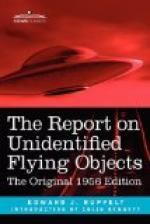By December work on the planning phase of our instrumentation program was completed. During the two months we had been working on it we had considered everything from giving Ground Observer Corps spotters simple wooden tracking devices to building special radars and cameras. We had talked over our problems with the people at Wright Field who knew about missile-tracking equipment, and we had consulted the camera technicians at the Air Force Aerial Reconnaissance Laboratory. Astronomers explained their equipment and the techniques to use, and we went to Rome, New York, and Boston to enlist the aid of the people who develop the Air Force’s electronic equipment.
Our final plan called for visual spotting stations to be established all over northern New Mexico. We’d picked this test location because northern New Mexico still consistently produced more reports than any other area in the U.S. These visual spotting stations would be equipped with a sighting device similar to a gun sight on a bomber. All the operator would have to do would be to follow the UFO with the tracking device, and the exact time and the UFO’s azimuth and elevation angles would be automatically recorded. The visual spotting stations would all be tied together with an interphone system, so that as soon as the tracker at one station saw something he could alert the other spotters in the area. If two stations tracked the same object, we could immediately compute its speed and altitude.
This visual spotting net would be tied into the existing radar defense net in the Albuquerque-Los Alamos area. At each radar site we proposed that a long focal-length camera be synchronized to the turning radar antenna, so that any time the operator saw a target he could press a button and photograph the portion of the sky exactly where the radar said a UFO was located. These cameras would actually be astronomical telescopes, so that even the smallest light or object could be photographed.
In addition to this photography system we proposed that a number of sets of instruments be set out around the area. Each set would contain instruments to measure nuclear radiation, any disturbances in the earth’s magnetic field, and the passage of a body that was giving off heat. The instruments would continually be sending their information to a central “UFO command post,” which would also get reports directly from the radars and the visual spotting stations.
This instrumentation plan would cost about $250,000 because we planned to use as much surplus equipment as possible and tie it into existing communications systems, where they already existed. After the setup was established, it would cost about $25,000 a year to operate. At first glance this seemed like a lot of money, but when we figured out how much the UFO project had cost the Air Force in the past and how much it would probably cost in the future, the price didn’t seem too bad—especially if we could solve the UFO problem once and for all.




